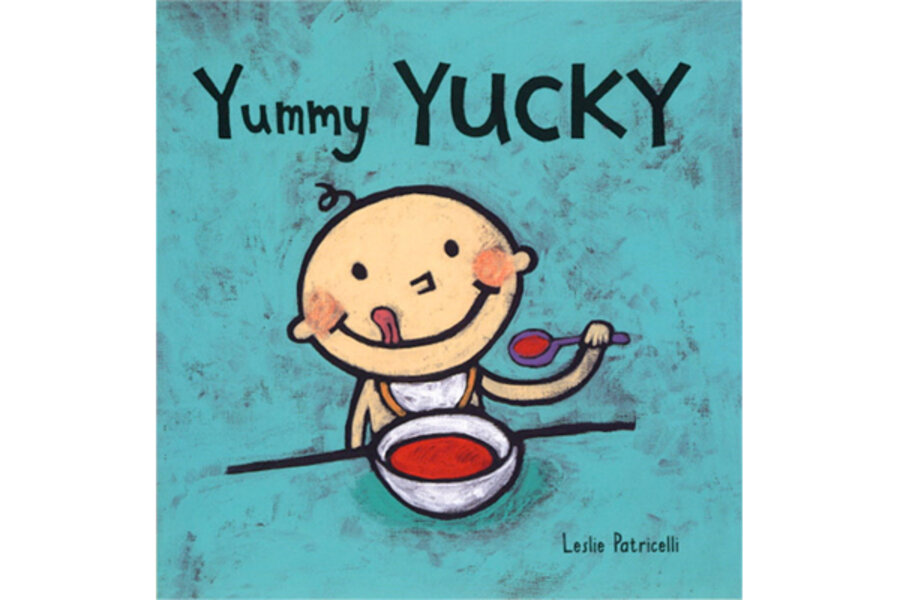Cookies are replaced by vegetables in new children's books
Loading...
| NEW YORK
Leslie Patricelli didn't keep junk food in the house when her three kids were toddlers, but the goofy, bald baby in her board book "Yummy Yucky" grins from ear to ear over chocolate sauce and cookies.
The prolific picture book writer also included pepperoni pizza as a positive, acknowledging in a recent interview that some of her empty calorie imagery for kids too young to seek out sugary and fatty foods on their own have earned her a kvetch or two from parents.
"If I were to do it again I would probably make a few different choices, but I don't think I would leave everything out," said Patricelli, in Hailey, Idaho. "All you have to do is watch a kid eat a piece of cake to know that they're in heaven."
Heaven, indeed, especially when it comes to an abundance of frothy pink cupcakes, chocolate chip cookies and candy in books aimed squarely at babies, toddlers and preschoolers who may not be intimate with the meaning of moderation.
But some authors and publishers are focused on creating alternatives to c-is-for-cupcake picture books for parents struggling to promote broccoli. Even Cookie Monster sometimes eats smarter, chowing down on celery and demonstrating smaller portions of his namesake treats in "Ding Dong, Elmo's Here!" and other books from the folks on Sesame Street.
"Food is everywhere kids turn," said Betsy Loredo, executive editor for Sesame Workshop's publishing group. "So it's natural for us to want to think of ways we can integrate that and make choices that are healthier. We try to go for at least equity."
Sesame Street, with an appearance by obesity fighter and first lady Michelle Obama, took on nutrition and exercise as an initiative back in 2004. The effort expanded to other divisions and special projects that included distribution of kits to six million families and child care centers offering ways to eat healthy on a budget and educate parents on the difference between "sometime food" and "anytime food."
With the childhood obesity rate tripling in the past 30 years to 1 in 3 children in the United States overweight or obese, books with healthy eating pictures and messages may not be everything, but they're something, advocates said.
Sesame Workshop, for instance, concluded in a 2010 study that when children are shown fruits and vegetables linked with favorite characters from the show they choose those foods at a much higher rate and eat more of them, according to Sesame researcher Jennifer Kotler.
Even broccoli, she laughed.
"Something happens between 3 and 5 where there's a growing awareness of what healthy means. Where 3-year-olds like the foods they like, 5-year-olds know things they might choose might not always be the healthiest," Kotler said.
David Goldbeck in Woodstock, N.Y., isn't an absolutist, but he does care about what kids see in their books when it comes to food. He wants more of them to eat fruits and vegetables, so he co-wrote an alphabet book that puts broccoli and yams in equally healthy company.
The Michigan Fitness Foundation, which is home to that state's Governor's Council on Physical Fitness, Health and Sports, uses Goldbeck's "The ABC's of Fruits and Vegetables and Beyond" in take-home book bags that are part of a health literacy program in more than 400 public elementary schools, said Marci Kelly Scott, the organization's vice president for health programs.
The book includes an alphabet format with illustrations (E is for eggplant!) but also history, fun facts and recipes for older kids. Scott ordered 500 of the books in 2008 and routinely reorders to keep up her supplies.
In this alphabet world, C is for carrots, D is for date, as in the "desert fruit found in Kuwait," and O is for organic.
"I wanted to make these words familiar to kids so they're not so loaded," Goldbeck said. "These things have a history to them." The book skirts on some buzz foods, making H for the herbs on pizza and V for vanilla, which sometimes flavors ice cream cones!
So what accounts for the cupcake-creep?
"I don't think parents really look at every book, page by page. They buy online or grandparents buy or they get books as gifts," Scott said. "Mostly parents put their trust in the book stores and the publishers."
Picture book illustrator Betsy Johnson in Portland, Maine, was thrilled to take on cauliflower and figs in an alphabet book depicting healthy foods by their colors. Her mixed-media collage work with text by Libby Koponen is featured in "Mmm...Let's Eat!" from Blue Apple Books and just out in May.
The book isn't entirely about food and includes other items by color like a yellow rain boot and a sunflower. The same goes for Sesame Street's 2011 "Abbie's Pink Party," telling the story of a birthday bash with a final spread featuring cake and other treats that include watermelons and strawberries.
As a mom of two girls, ages 10 and nearly 13, Thompson worries about the motives behind unhealthy food choices in books for kids.
"I don't think you need to beat kids over the head with things because I think kids are a lot smarter than people give them credit for, but a lot of people in the business are looking just at what will sell, and I'm totally horrified by it. That's not how I've ever fed my kids," she said.







